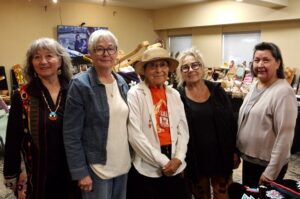Exhibition aims to revive the creation of tikinagans

By Rick Garrick
THUNDER BAY — An exhibition of about 260 tikinagans and cradle boards from across Turtle Island was featured during the Anishinabek Nation’s Indian Residential School Research and Recovery Methodologies Knowledge Exchange gathering held from Oct. 8-10 in Thunder Bay.
“They’re all different types, they’re from different tribal groups, different nations,” says Shirley Stevens, Red Rock Indian Band citizen and organizer of the exhibition. “Tribes living side-by-side in their territories often borrowed from each other in terms of how [their tikinagans] were engineered. They are a marvel of engineering, which says a lot about the women who made them.”
Stevens says she began searching for tikinagans after her daughter’s tikinagan went missing during a move back home from Ottawa.
“It turned out that all across North America, the art of cradle board-making is being lost, so I thought I was only going to get a couple and I didn’t care what shape they were in,” Stevens says. “And a couple has ended up being about 260 of all sizes, from an inch to four feet tall.”
Stevens says the exhibition features tikinagans from California, the northwest coast, the near north and far north, the prairies, eastern woodlands, east coast, south-east coast seaboard, and the very south.
“A couple of them were probably made in the 1860s-70s,” Stevens says. “You can tell how incredibly skilled they were because they threaded these teeny tiny beads and I have no idea how they did it — this one is made from beads and buffalo hide, hawk bells, and some linen on the inside that you can see and some leather.”
Fort William Elder Marlene Pierre says the exhibition is probably better than the Smithsonian Institution’s display of tikinagans.
“The reason why I’m so excited about this display is we’re trying to revive the resurgence of the cradle board to get our women back to making these,” Pierre says. “These cradle boards are the first way in which we bring our children into the world — when they’re in those cradles, they are safe, they’re comfortable.”
Pierre says the tikinagans were easily transported as well.
“We take them out when we’re blueberry picking, we lean it up against a tree,” Pierre says. “One of the things that was pointed out to me is when the babies are in there, they can see the world all around them. So they start getting in tune with nature from the very beginning.”
Netmizaaggamig Nishnaabeg’s Beverly Sabourin says the collection includes three tikinagans that were made by her grandparents, Alice and Patrick Sabourin.
“My grandmother has made a tikinagan for almost every grandchild in our family,” Sabourin says, noting that her grandmother’s trademark was burnt circles and carved flowers. “When I go visit my cousins in Dryden or wherever, they all have a tikinagan like this hanging in their place. My grandmother must have made thousands of cradles, for her grandchildren for sure, but she also made them for people that wanted to buy them.”
Sabourin says the last tikinagan her grandmother made was also in the collection, noting it was made in 1985 for her son.
“This one is mine,” Sabourin says. “I was in that cradle, so that is 76 years old.”
Anishinabek Nation Grand Council Chief Linda Debassige says it was a “pretty overwhelming” experience when she first saw the exhibition.
“It all proves that we have always, since time immemorial, knew how to care for our children,” Grand Council Chief Debassige says. “We knew how to protect them, we knew how to keep them safe, we treated them with such delicacy and such gratitude as gifts given to us by Creator.”
Grand Council Chief Debassige says all of the different colours and designs of tikinagans, including the older cradle boards on display, show how much Indigenous people treated their babies with the utmost importance.
“Seeing them from the different regions just goes to show that no matter where we are on Turtle Island, we have always cared for our children and ensured their safety, well-being, and their love,” she says. “Looking at the cradle boards, it really reminded me how we taught our children since birth to look around, to be a part of our lives, and even where they’re carried, they’re carried at the eye level of others. So even though they’re small, their spirit is so great and so powerful that they’re amongst us equally as well.”


